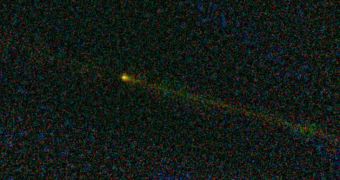Experts operating the Wide-field Infrared Survey Explorer (WISE) telescope announce that they have just seen traces of the comet Hartley 2, which the NASA EPOXI mission is getting ready to rendezvous with.
The meet-up between the two objects is scheduled to take place on November 4, after the former Deep Impact spacecraft, now dubbed EPOXI, spent several years tracking the comet down through the inner solar system.
With the aid of the new observations carried out by WISE, experts hope to be able to put together a comprehensive view of the peculiar comet.
“WISE's infrared vision provides data that complement what EPOXI will see with its visible-light and near-infrared instruments,” explains scientist James Bauer.
“It's as if WISE can see an entire country, and EPOXI will visit its capital,” adds the expert, who is based at the NASA Jet Propulsion Laboratory (JPL), in Pasadena, California.
Even before EPOXI meets up with Hartley 2, experts will get new datasets on the size of the space rock's nucleus, as well as more details about the composition of the dust particles it sheds.
When astronomers will combine this knowledge with the observations EPOXI will conduct, they hope to get a clear enough image of the way the comet is set up so as to infer its history.
Knowing how wandering space bodies evolve over time is very important for studies seeking to determine how the solar system looked like in its earliest days, when asteroids and comets were produced.
WISE is not the only telescope to participate in studying Harley 2. A variety of other space- and ground-based observatories are also keeping an eye on the comet, in a bid to collect as much information about it as possible.
Hartley 2 will reach its closest approach to Earth on Wednesday, October 20. The body was first discovered back in 1986, and researchers have been studying it ever since.
The IR observatory is conducting the new investigation under the NEOWISE Post-Cryogenic Mission, an extension to its original science mission, which ended recently. i
Since being launched, on December 14, 2009, WISE observed and cataloged more than 150,000 asteroids and 110 comets. At this point, it is focusing its attention on Near-Earth objects (NEO).
“Astronomers can reference our catalog to get detailed infrared data about their favorite asteroid or comet,” explains researcher Amy Mainzer.
“Space missions can also use our observations for more information on their targets, as EPOXI is doing,” adds Mainzer, who is the principal investigator of NEOWISE at the JPL.

 14 DAY TRIAL //
14 DAY TRIAL //